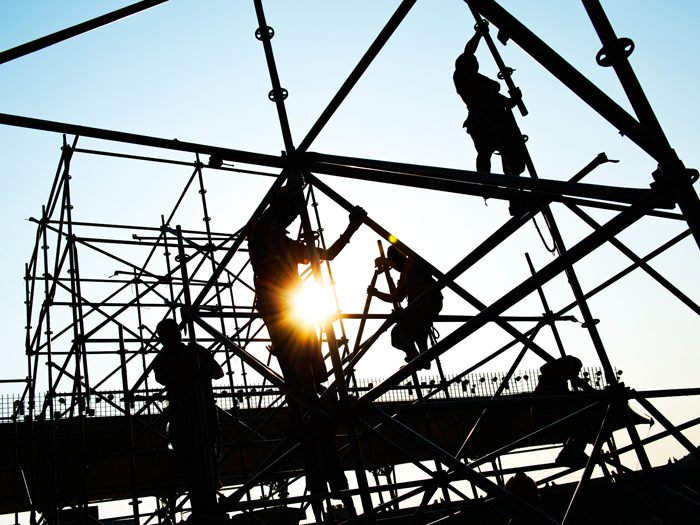Construction Risk
11 Critical Risks Facing the Construction Industry

From slips and falls and weather-related business interruption to fires and stolen equipment, construction sites will face innumerable risks every day. As a complex sector for insurance professionals to insure, the industry will need to prepare for these growing and emerging risks.
Added to that, construction is booming in the U.S., leaving it vulnerable to even more dangers.
Builder’s risk insurance is designed to protect the structure or building, employees on site and the raw materials being used. But builder’s risk doesn’t cover for faulty workmanship or poor materials. Exclusive remedy in workers’ compensation is being challenged daily, as well, and is a pain point for contractors across the country and particularly in New York, where the Scaffold Law has opened the door to hundreds of thousands spent on litigation. On top of that, increased frequency and severity of natural disasters has delayed sites from completing projects on time, hurting productivity and increasing the need for business interruption coverage.
Construction risk managers and contractors need to be on the top of their game. Know the risks involved; learn how to prevent them from happening. Whether its residential or commercial, a project needs a keen eye from start to finish.
1) Shifting Workforce
The skilled labor shortage, an aging workforce and an influx of inexperienced workers is driving up costly accidents and injuries on construction sites.
The Associated General Contractors of America (AGC) wanted to put a number to the talent gap, conducting a survey that questioned contractors about their current workforce. AGC found that 78 percent of firms are having trouble finding qualified workers.
Labor-shortage pain hit home when long-term workers were laid off during the U.S.’s economic downturn a few years back. More than two million jobs were lost. Add to that an aging population — baby boomers are continuing to retire at rapid pace — and few millennials entering into this manual labor career.
It’s a recipe for disaster.
Around 21 percent of construction industry employees are age 55 and older, while just 9 percent are 24 or younger. This leads to a heightened risk of injury or illness due to less experience in the field and few mentors to help the younger generation learn best practices. Construction holds the lead in all industries with the total number of worker deaths each year.
Not to mention, as more women enter into construction, the industry has yet to embrace safe equipment for them.
2) Construction Defect
With a less-experienced workforce, long-tail construction defect claims are on the rise.
Construction defects refer specifically to any defect in the design, workmanship or in the materials used on a project. (Think of the Leaning Tower of Pisa, sinking into the earth because its builders didn’t check the surrounding soil conditions.)
Construction defect claims arise from mishaps of all sizes and types of projects. The payout can be steep if a court rules in favor of the plaintiff.
These defects are resulting in failures to buildings or structures and leading to property damage and human injury. Construction defect claims arise from mishaps of all sizes and types of projects. And while commercial general liability (CGL) insurance is designed to protect construction companies from such claims, the payout can be steep if a court rules in favor of the plaintiff.
There are also exclusions to CGL that will leave a construction firm vulnerable if a construction defect claim arises. These exclusions include pollution, electronic data and war, to name a few.
3) Contractual Risk
Owners continue to shift more liability to contractors via contract language. This is especially tricky when it comes to workers injured on a construction site.
Contracts are used to bend the exclusive remedy provision of the Workers’ Compensation Act. This provision provides workers with compensation in the event of injury or illness while protecting employers from being sued for liability by workers injured on the job. Workers’ compensation acts as the sole remedy to address workplace injury.
Sometimes the wording in a contract drawn up between a subcontractor and a general contractor may state that the subcontractor waives its right to the exclusive remedy protections of the Workers’ Compensation Act. This could then expose the subcontractor to a personal injury claim by its own employee, explained Mark A. Lies, labor attorney, Seyfarth Shaw LLP.
In many of these cases, the subcontractor does not realize they waived their exclusive remedy protection until an employee injury occurs. When this happens, the third party is protected by workers’ compensation if a worker is injured, but the contractor is left vulnerable to personal injury liability suits.
“We see potential waivers all the time,” added Lies.
4) Overextension
Increasing demand may drive general contractors and subcontractors to take on larger or more projects than they have the capacity to handle. This not only acts as a huge safety risk, but overextension can also exacerbate defects and site accidents.
Building is booming in the U.S.; billion-dollar projects are no longer “abnormal” in construction anymore. And with contractors working to keep their firm ahead of the competition, it’s no wonder they’re taking on too big of projects with little bandwidth or resources to complete all of them. In fact, many overextend and take on projects outside their scope of practice.
When looking at the top five reasons why contractors fail, unrealistic growth — which includes overextension and taking on too much work — ranked as number one with 37 percent.
When looking at the top five reasons why contractors fail, unrealistic growth — which includes overextension and taking on too much work — ranked as number one with 37 percent, according to Surety Information Online. Performance issues, which includes inexperience with new scopes or types of work, came in at a close second with 36 percent.
Beyond construction, underwriters for the construction industry are feeling the pinch as more construction sites aim to take on bigger and broader jobs. The sheer volume of the work is a concern for underwriters, particularly projects costing billions of dollars.
5) Fire
Poorly managed hot work activities or shortfalls in site security, especially in wood-framed construction, can result in costly losses.
A construction site fire isn’t that uncommon. A single spark from a sander, welder, a cigarette, electrical wire, temporary lighting and the like will easily set wood, solvents, packaging or gasoline — all found on construction sites — up in flames.
Fire risk in renovation construction is especially high, because older homes and buildings contain studs that start in the basement and run up to the top of the house. If a fire were to start, the very core holding the building up could send a flame throughout the entire structure.
Munich Re released a fire loss prevention guide specifically for construction sites. It noted fire needs three things to become self-sustaining: heat, combustible material and oxygen.
Construction sites will have all three at any given moment throughout the building process because of the very nature of its work. Ensure the heat, material and oxygen are not combined in an uncontrolled manner. Training is key.
6) Site Protection
Unattended jobsites can result in unknown damage from leaking or frozen pipes, smoldering hot work, and theft/vandalism of equipment and materials.
A well-lit, fenced in construction site is less likely to be vandalized than one with nothing guarding it. Unfortunately, not all sites will have extensive security during its off hours, and unattended projects are vulnerable to damage and vandalism.
One pipe with a small crack can leak more than 250 gallons of water per day, destroying walls, floors and tools if they are in the line of fire. Draining the pipes or keeping a site warm are two methods to protect pipes from leaking, freezing or bursting and save thousands on replacement and repair.
In addition, the price of stolen materials can add up. Losses in construction theft estimate $1 billion annually. A construction site will face the indirect costs of increased insurance premiums, rental costs to replace stolen equipment and machinery, and lost productivity while waiting to replace inventory.
There are some ways to protect against unwanted vandals, which can prevent loss on construction sites. Contractors should keep detailed records of all materials, secure equipment in safe places when not in use and register the construction site’s heavy equipment with their insurer.
Additional Risks
7) Natural Disasters
8) Financing Big Projects
9) Regulatory Change
10) New Technologies
11) Missed Deadlines
For your own chance to rank the top growing risks in construction, visit Risk & Insurance®’s Construction Risk List, where you can decide which risks are most pressing. You can then submit your answers and see what other risk professionals had to say about the top construction risks. &









